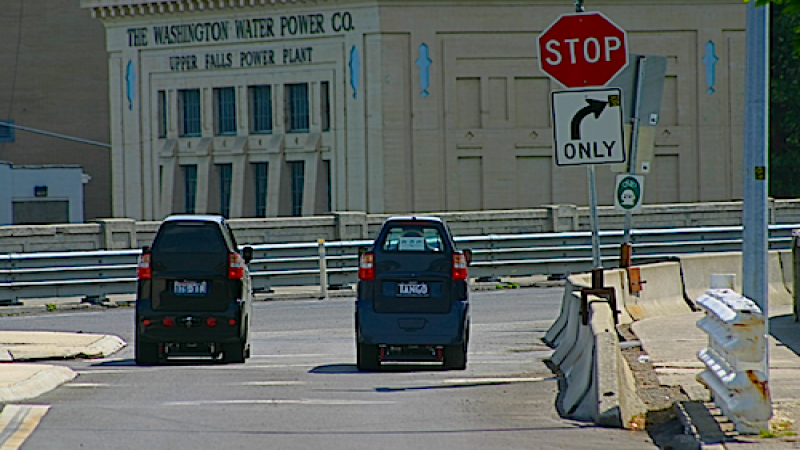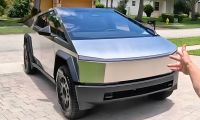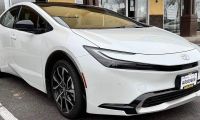A conventional internal combustion engine, ICE car is difficult to design, manufacture and maintain. Opposing pistons are not the most efficient mode of propulsion since with each action comes its opposite. While the gasoline engine has made great strides in a century, it has limits. An electric motor, either inside a wheel or on a differential is still more efficient. The last problem is to solve the price and weight of batteries.
The Real Problem With EVs. If we get down to it, the real problem with electric vehicles, EV is not the range. Most people travel less than almost any range offered by any EVs. Battery weight is not an issue either. A commuter car doesn’t need to have state of the art lithium batteries to drive a few miles. With that in mind, Rick Woodburry proved an EV can be free from the constraints of an ICE design. When he designed his Tango, he designed it with congested city traffic in mind. The Tango is so tiny, you can fit two side by side in one lane. The trick was to put driver and passenger one in front, the other behind, as in motorcycle driving.
How Tough & Roll Over? It’s tough. With its NASCAR strength internal roll cage, it can withstand head on collisions better than your SUV. How tough? The roll cage meets or exceeds FIA racecar regulations, which means it is designed to protect the occupants crashing at over 200 mph. What about roll over? If you’ve noticed the design of the EV, your first thought would be that it could tip over. Yes, it’s a tad bottom heavy but in the world of EVs, that is a good thing. The lower the center of gravity, the better than handling. In fact Rick told me back in 2007 a 911 Porsche would tip over before the Tango would. Why is that? Originally Rick felt lead acid batteries offered sufficient performance. The Tango just didn’t need the lighter lithium batteries. See below how well it performs.
Technically Speaking. While no small weight, the T600 comes in at 3,326 lbs. Using 1,000 Headway 10Ah 38120S Energy Cells, or 8Ah 38120P Power Cells, they give out 100 or 80 Amp hours respectively, 100 in series with 320 Volts nominal. The 2 Advanced DC FB1-4001 9" electric motors driving each rear wheel put out over 3,000 ft-lb of combined torque. The range is 100 miles at 70 mph on a level freeway or up to 120 miles at 60 mph. A newer 60 kWh pack of Wide Energy Cells is under development, hinting at a 200-mile range at 70 mph, or up to 240 miles of range at 60 mph or less. Acceleration is lightening fast with 0 to 60 in 3.2 seconds making the Tango beat a $440k Porsche Carrera GT. The rest of the numbers are equally impressive, 12.503-second for the 1/4-mile at 106.21 mph, after being driven to the track 10 miles, and up a 500-foot grade without recharging first.
Charging is pretty fast also with a 40 amp on-board charger compatible with J1772 and a new 200 amp off-board charger is under development.
Price. Price is always the sticky point with new EVs and Rick now has a waiting list of lower price Tangos. Sit down, the T600 is not for most people. It starts at $158,000 with a $10,000 deposit, batteries and motors not included. It’s still cheaper than an exotic gasoline car. Not your everyday car but one heck of an exercise proving EVs break from the mold with performance in mind.
What’s so special about Rick’s Tango T600 is that it’s the perfect “commuter car” for busy city driving. If George Clooney had one, it must be good, right? It also shows how removing the constraints of a gasoline engine and tank opens up possibilities by rearranging driver and passenger position, allowing for lane splitting, i.e. driving between cars or have two tangos drive next to each other. Commuter Car’s Tango is one EV that disrupts common designs and constraints of vehicles.












Comments
$158,000 and no motor or
Permalink
$158,000 and no motor or batteries. I'm 100% behind the development and employment of EV 's, but you have to out to lunch if you think you can sell the Tango at that price point. And just how do you justify that price in a vehicle that is intended too be a production vehicle?
Well, the gist of the
Permalink
In reply to $158,000 and no motor or by Three Deuce (not verified)
Well, the gist of the article, which is stated clearly in the title is how designing EVs liberates engineering from the gasoline platform constraints. I debated whether or not to talk about the price knowing well someone might pick it up more than what is essential.
When I see a $158,000, I don't get upset. It's not a car I can afford. I move on. When I think of those who can afford a $450 Porsche Carrera GT, I feel the Tango is a fun little car to experience. Being an entrepreneur, I'm happy people like Rick do what they do and understand full well that prototypes are very, very expensive. No one subsidizes entrepreneuralship in our country, only big companies. The point was how an EV platform gives a lot of freedom to design vehicles, such as the possibility to lower the center of gravity and rearrange almost anything in the design of the vehicle.
Nicholas: You forgot to tell
Permalink
In reply to Well, the gist of the by Nicolas Zart
Nicholas:
You forgot to tell them how well the Tangoes at the drag strip!
Yes, I wondered whether or
Permalink
In reply to Nicholas: You forgot to tell by Anonymous (not verified)
Yes, I wondered whether or not to include it but then again it was more about EV designs opens more possibilities then ICE. Yes, the Tango at the drag strip virtually leaves other cars behind... way behind. I love this EV. It's odd, quirky, drives like crazy and is different, something I would to see more from cars instead of this sea of bland look-alike.
Hello! Nicholas, Clearly,
Permalink
In reply to Well, the gist of the by Nicolas Zart
Hello! Nicholas,
Clearly, I'm not questioning the intent of the article with my comment, but as a retired, designing, automotive/mechanical/aeronautical engineer who understands the complexity and costs necessary too bring a vehicle to production, and who drives, on occasion, a 91' EV Miata that I built 6 years ago, I find the all in price point, unsupportable.
Good design/engineering should include production efficiencies, even in a limited production vehicle.
Regarding the intent of your article..."an EV platform gives a lot of freedom to design vehicles," Nothing in the physical design of the subject vehicle is unique because it employs an EV platform. EV vehicles do require unique engineering componentry, when compared to and 'IC' vehicle, due to the lack of limited available energy for air conditioning and battery heat in cold climes, and battery and systems safety. There are more engineering considerations in the design of an EV, but the design envelope isn't one of them.
What does allow for some latitude of expression, is the category of vehicle employed. Google it 'Vehicle categories', for more info.
Regards Tre.
Hi Tre, You're right good
Permalink
In reply to Hello! Nicholas, Clearly, by Three Deuce (not verified)
Hi Tre,
You're right good engineer should take into consideration mass-production but that is an ideal not always reachable for an entrepreneur. Rick's point is that a $160,000 that keeps up with the $450,000 Porsche is something to think about. Just imagine if ever it got under way and mass produced.
As far as engineering and designing an EV, the problems you are referring to are mostly modern day amenities and security features. The cooling system on the CODA does not have a big footprint and overall adds to performance. And that is within a car originally designed for a gasoline setup. The Model S is probably the best example. When I first spoke to Franz von Holzhausen at Tesla back in 2008, he was so excited building a car from scratch without the constraint of a gasoline engine and fuel system. What he meant by that was a better use of space and Tesla's battery thermal management is minimal compared to the CODA. But look at the result. Of course EVs require a certain level of engineering and systems traditional ICE engines don't have, but overall I would say the design is less cumbersome, leads to lower center of gravity and make up for the extra battery weight while still showing impressive performance. In this aspect, it does leave a lot of freedom ICE engineers don't have, save for a flat-piston engine... but even that has a lot that needs to go on top in order to make it efficient. Most of it is mostly electronics, and at that on the software side.
Anyway, you make a good point but I still feel designing an EV leaves more room above than an ICE does.
Reg; $160,000 The article
Permalink
In reply to Hi Tre, You're right good by Nicolas Zart
Reg; $160,000
The article states $158,000, plus battery pac and motor, which could easily add another $35,000 plus dollars to the final cost, unless lead/gel energy cells are used. By any metric, thati s a sizable amount of treasure, especially when compared to other available EV choices. let alone efficient 'IC' models.
And compared to the Hunter 27e cruising sailboat at $69,990(not apples & oranges, but) one has to wonder where the value is?
Well, the car competes in
Permalink
In reply to Reg; $160,000 The article by Three Deuce (not verified)
Well, the car competes in another arena than any of the regular EVs or the sailboat for that matter pf fact. Again, this is a car you can pit next to a Porsche Carrera GT, not a $40K EV.
I think we all see value differently but if I could afford Ferraris and Porsches, this below $200K EV would be a bargain for around town.
This is an interesting
Permalink
This is an interesting discussion. Creating a one-off and a prototype for production are two different problem and budget sets. I was happy with my $4K conversion until I got to drive a TESLA Roadster: Driving a purposed design, built with an ample budget was life changing, again. I think the Tango fits the category but was so far ahead of the Tesla line, father & son may not have been considering the long term business plan, something Tesla has done very well at. WE are all standing on each others shoulders.
I am lucky to be mentoring 2 teams of YoungMakers, One, a ground-up solar car, the other, an EV conversion. Both are winning teams already because their school sees the wisdom in offering a Young Maker studio/class. Other classmates have great and challenging projects as well.
Watching the progress of the two groups will be very instructive as per this discussion. I will let you know how things progress.
The YoungMaker season begins January 19 at San Jose's Tech Museum, Lawrence Hall of Science in Berkeley and Presidio School in San Francisco so if you know of some kids who have a hankering to make things, it's not too late for them to join in. They do need adult affiliation, preferably an adult with some skills/connections and room in the garage for them to work. It does not need to be a school project. You can google it.
Thanks for the addition of
Permalink
In reply to This is an interesting by Anonymous (not verified)
Thanks for the addition of your comments 'Anonymous', especially the inclusion the 'YoungMakers' project. And kudos too you in that regard.
I did something similar with youths in early 2000's with light boats and kayaks. I included elements of marine design theory/engineering and math, too show youth what math can contribute to the creation of a watercraft/vessel. It was a very worthwhile and enjoyable few years.
As regards; 'Creating a one-off and a prototype for production are two different problem and budget sets.'
Quite true, but development costs have too be amortized over the production run, not all up front for the first customers, which I suspect is happening with the Tango. The budget and accounting are as important as the design and engineering, they are inseparable if you want to have a successful product. Unfortunately, most idea guys are not realistic businessman.
I have designed, engineered, and built both 'one offs' and production prototype vehicles, including aircraft, autos, and ATV's, so understand the difficulties inherent in such projects.
Only one saw limited production, a Vietnam era ALAAV/Advanced-Light- Amphibious-Attack Vehicle for the Army. None was ever deployed with a combat unit, but the 27 examples did prove the concept and then I heard, become toys for officers. You can now buy similar vehicles in the private market.
Was that 2000 effort with
Permalink
In reply to Thanks for the addition of by Three Deuce (not verified)
Was that 2000 effort with youth called 'Electrathon'?
Reg; "Was that 2000 effort
Permalink
In reply to Was that 2000 effort with by Anonymous (not verified)
Reg; "Was that 2000 effort with youth called 'Electrathon'?"
No, as stated, it was about building light small craft/boats/kayaks
It would be great to see how
Permalink
In reply to This is an interesting by Anonymous (not verified)
It would be great to see how your YoungMaker experience turns out. I think that generation will make sense of EVs much more than our generations can. And you;re right, a prototype and a one-off are two different things. Fortunately, the one-off becomes a concept, then a prototype and finally a produced car.
The order is ...first, the
Permalink
In reply to It would be great to see how by Nicolas Zart
The order is ...first, the Concept, which leads to one or more, 'proof of concept', then production prototypes leading to production examples, leading to production. In the auto industry, the proof of concept and production prototypes, and production examples, are usually recycled or crushed and recycled after testing.
True, it's always sad when
Permalink
In reply to The order is ...first, the by Three Deuce (not verified)
True, it's always sad when you think the test cars you were driving end up in the crusher. All the little CODAs I drove not too long ago are gone. But this also gives us quality cars in the future.
I'm still happy we have entrepreneurs in our country who are going out there doing something.
I think the thing that people
Permalink
I think the thing that people are getting hung up on is that "commuter car" and "$160,000" are just not compatible ideas. Especially, when you can have a Car of the Year for about a half to a third less.
That's true and the last
Permalink
In reply to I think the thing that people by Brian (not verified)
That's true and the last article I wrote today is about that, getting hung up on superficialities. Yes, commuter cars and $168K are a brain tease but we've come to accpet a lot of products and services as good when far better ones are available.
The idea behind Commuter Cars is that they truly excel while commuting. Two can drive side by side and you can lane split with amazing performance.
HI! I am returning to this
Permalink
HI!
I am returning to this thread because that is where the dialog started & it is still here!
the high school EV conversion team I am mentoring found a donor truck [a small Ford] last week while I was sick. This Monday they pulled the engine and have a buyer for the old engine.
When you have students like this, it is easy to work for free! I just wished they'd power washed the engine & tranny before they pulled it, but how else are they going to appreciate how clean EVs are?
Next Monday I've been asked to sit on their senior project review panel, they are already well in to it!
Now.. about the solar car team.....
Let us know how it develops.
Permalink
In reply to HI! I am returning to this by Anonymous (not verified)
Let us know how it develops. Thanks, Nicolas